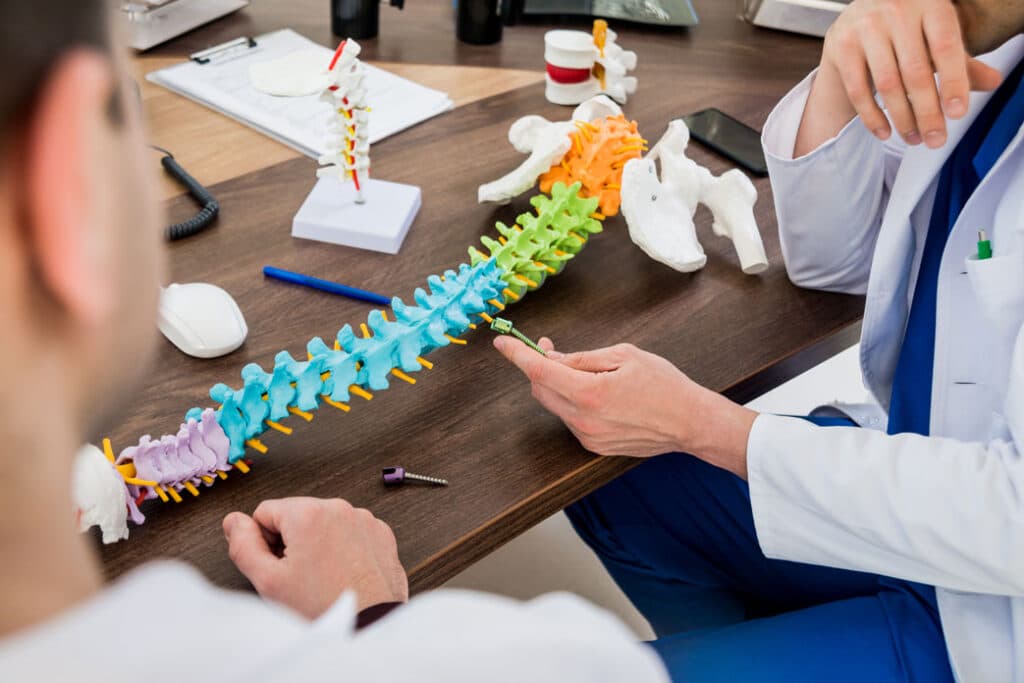Spine surgery is no different from other types of surgery in that it could result in complications. The dangers of your procedure are probably one of your first inquiries if you have planned spine surgery.
We’ll aim to address some basic questions and worries about spine surgery, along with the most typical spine surgery side effects, when you should be concerned, and how to prevent them.
What is Spine Surgery?

Spine surgery refers to surgical procedures that are performed on the spine, which is the bony structure that runs down the middle of the back and protects the spinal cord. The goal of spine surgery is to treat various conditions and disorders affecting the spine to alleviate pain, restore function, and improve the patient’s quality of life, such as spinal tumors, herniated discs, bone spurs, scoliosis, or spinal instability.
What Are Common Complications of Spine Surgery?

It’s crucial you provide complete answers to inquiries about your medical history, allergies, medication regimen, and lifestyle choices during pre-surgery consultations with your medical team because doing so will help your doctor better understand the procedure’s potential risks. Your risk for a surgical complication can be influenced by a variety of factors, including:
- General well-being
- Previous experience with surgery
- Medical diseases that coexist (like diabetes)
- Smoking history
- Osteoporosis
Fortunately, it is extremely unlikely that any of the general surgery side effects described below may develop during or after your procedure. Even so, the following list includes potential general spine surgery complications, mostly to raise awareness.
Bleeding
From making the incision to sewing it up, your spine surgeon will take great care to restrict blood loss. However, there is a risk of serious bleeding if major blood vessels are damaged.
How to Prevent Bleeding After Spine Surgery
Your surgeon will take these precautions to lessen the risk of bleeding:
- Collect a sample of your blood. If they need more blood than expected during surgery, your doctors may collect a sample of your blood before the procedure or your blood type. This is often accomplished also by receiving blood from a donor. But donating your own blood before surgery is an option for some people who wish to avoid using donor blood products.
- Intraoperative blood salvage or auto-transfusion. Recovering one’s own blood through suctioning at the surgical site during surgery is known as intraoperative blood salvage or auto-transfusion. A cell-saver device or other specialized equipment gathers your blood, filters and cleanses it, and then returns it to your body through an intravenous line.
Risk of Infection
In most people, the risk of infection after spine surgery is minimal. Before surgery, you will start receiving IV antibiotics to lower your risk of infection. If an infection arises, it may be superficial (limited to the skin incision) or extend more deeply to the vertebral and spinal cord regions. The following are typical infection signs and symptoms:
- A large, heated, and red wound.
- Greater pain.
- Fever, occasionally with chills.
- Yellow or clear pus pouring from the wound.
- A vile odor coming from the wound area.
How to Prevent Risk of Infection After Spine Surgery
Preventing infection after spine surgery is a crucial aspect of postoperative care. Here are some standard measures a surgeon does to help reduce the risk of infection:
- Preoperative preparation. Before surgery, it is important to optimize the patient’s health. This includes controlling chronic medical conditions, such as diabetes, and addressing any active infections.
- Antibiotics. Administration of antibiotics before surgery helps prevent infection. The specific antibiotic regimen is typically determined based on the patient’s individual risk factors and local antibiotic resistance patterns.
- Sterile environment. Maintaining a sterile surgical environment is essential. This includes adhering to strict hand hygiene protocols, using sterile instruments and equipment, and ensuring a clean operating room environment.
- Surgical site preparation. The surgical site is usually prepared by thoroughly cleaning the skin with an antiseptic solution to reduce the number of bacteria on the surface.
- Proper wound closure. The surgical incision should be closed meticulously to minimize the risk of infection. This may involve the use of techniques such as layered closure, subcuticular sutures, or skin adhesive.
- Postoperative wound care. The surgical wound should be regularly inspected and appropriately dressed to prevent contamination following surgery. The dressing should be changed as per the surgeon’s instructions.
Blood Clots (Deep Vein Thrombosis)
It is possible for clots to develop in the major veins of the calf and to grow until they reach the veins of the thigh or other areas, a condition called Deep Vein Thrombosis (DVT). They occasionally can go to the pelvic veins. If a piece of the clot escapes, it may go through the veins to the lungs and stop the blood flow to the occluded area of the lung. Pulmonary embolism is the name for this blood clot in the lung, and it can be fatal.
Blood clots might develop in the initial weeks following surgery. Among the warning signals of a potential blood clot are the following:
- Calf, ankle, or foot swelling.
- Above or below the knee, there may be tenderness or redness.
- An aching calf.
How to Prevent Blood Clots After Spine Surgery
Prevention and management strategies are employed to reduce the risk of DVT in patients undergoing spine surgery. These may include:
- Pharmacological treatment. The administration of anticoagulant medications, such as low-molecular-weight heparin or fondaparinux, before and after surgery can help prevent blood clot formation.
- Early mobilization. Encouraging patients to try moving and walking as soon as possible after surgery helps prevent blood clot formation.
- Hydration. Adequate hydration is important to maintain proper blood viscosity and prevent clot formation. Patients are often encouraged to drink plenty of fluids before and after surgery.
- Patient education. Providing patients with information about the signs and symptoms of DVT and emphasizing the importance of early reporting can help in timely diagnosis and intervention if DVT does occur.
Avoiding prolonged periods of inactivity following spine surgery is the best strategy to prevent deep vein thrombosis. Patients are urged to try walking and moving around as soon as they can. This enhances circulation and stops dangerous blood clots from forming as a result.
Dural Tear
A dural tear happens when the operation tears the delicate, protective layer covering the spinal cord and nerves. Sometimes, while performing surgery, your surgeon can spot a dural tear and instantly heal it. Dural rips typically mend without any problems. Spinal headaches can result from spinal fluid leakage via the tear, though, if it doesn’t heal.
Existing illnesses or physical abnormalities may increase your risk of a dural tear. You run a higher risk, for instance, if you use steroids, have diabetes, or smoke. Your risk is also elevated if you have spinal stenosis, scoliosis, kyphosis, or spondylolisthesis.
How to Prevent Dural Tear after Spine Surgery
Preventing a dural tear during spine surgery is a key goal for surgeons. While dural tears can occur even with the utmost care, certain measures can help minimize the risk. Here are some strategies to prevent dural tears during spine surgery:
- Surgery skills. Choose a spine surgeon with experience in your operation. Skilled surgeons can reduce dural tear risk.
- Imaging and surgical planning. Preoperative planning, including MRI or CT scan reviews, can reveal the patient’s anatomy, prior anomalies, and probable issues. The surgeon can avoid fragile structures with this knowledge.
- Gentle tissue handling. The dura mater, which protects the spinal cord, should be treated gently during surgery to avoid injuries. Surgeons handle tissues gently to avoid dural damage.
- Visibility. The surgical site must be visible. To improve visibility and reduce dural damage, specialist retractors, magnification equipment, or intraoperative imaging may be used.
- Hemostasis. Spine surgery requires careful bleeding control. Controlling bleeding prevents blurred vision and dural damage.
If you experience a headache after surgery, tell your surgeon. You may need extra surgery to repair a dural tear.
Book Your Appointment with Dr. Hamid Mir!

Dr Hamid Mir is a board-certified orthopedic spine surgeon with fellowship training in combined neuro and orthopedic spine surgery techniques who’s based in Orange County, CA. He has 18 years of experience in minimally invasive spine surgeries using advanced microscopic techniques.
With his expertise and compassionate approach, you can trust Dr. Mir to guide you through the diagnosis, treatment, and recovery process, ensuring the best possible outcomes for your spinal health. Don’t wait; schedule your appointment today and take the first step towards a healthier spine.
Risks from Spine Surgery Are Minimal, but You Should Know About Them
Although problems from general spine surgery are uncommon, it is nonetheless crucial that you know what to expect before, during, and after the procedure.
Ask your spine surgeon about the potential dangers of your particular back or neck surgery and any preventative measures you can take before deciding to go through with the procedure. You can make a well-informed decision about whether or not the treatment is right for you if you are aware of the dangers and can weigh them against the potential benefits.



